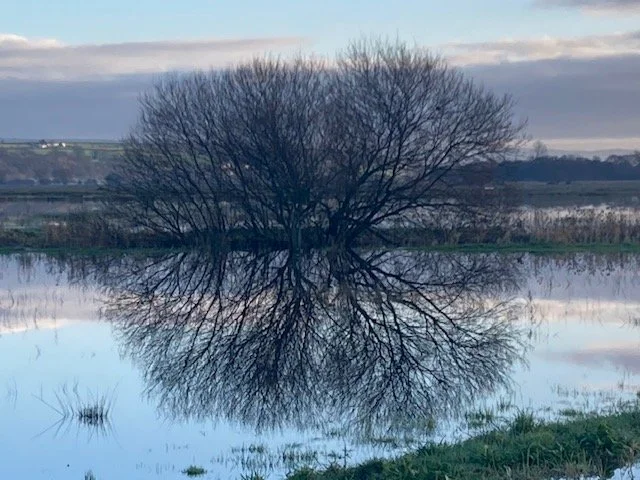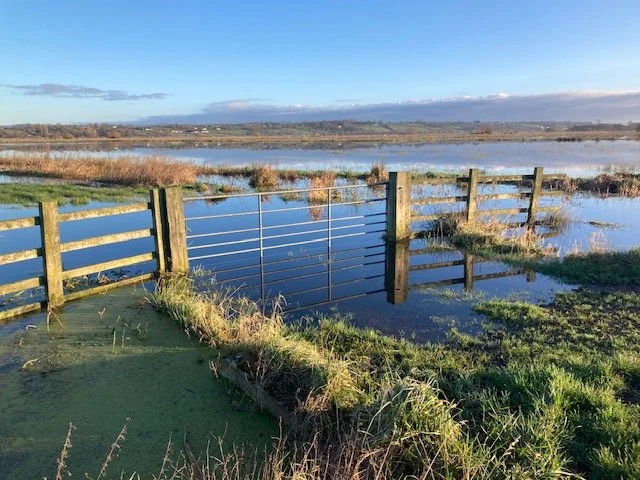2024 off to a flying start
Trip Report
10 – 12 January 2024
Tour Leaders: Graeme Mitchell and Brett Westwood
Wednesday 10 January 2024
After a couple of weeks of solid rain over New Year we were delighted to have a bright and sunny afternoon to start our first birdwatching excursion of 2024.
We dipped down from the village of Blackford and on to Tealham Moor where we were met by an expanse of flooded fields. The recent rains had almost completely covered the low-lying fields, turning them into a large inland lake. What was still above water seemed also to be covered in birds. There were a great many of our over-wintering thrushes – the larger fieldfare, clattering and chattering through the willows that lined the road, and the redwing (slightly smaller than a song thrush) with its distinctive light-coloured eye-stripe and red-coloured flanks.
Tealham Moor
We scanned the watery fields and quickly found our first egrets, a few cattle egrets, quite squat in size and stature, and a few much larger great white egrets dotted over the fields with several grey herons. At our feet a tiny chiffchaff hopped around like a little mouse looking for insects (more and more of these little olive-green warblers are over-wintering in the UK rather than heading off to warmer climes). A very dark buzzard sat motionlessly on a distant gatepost and a large flock of lapwings circled overhead, whilst three roe deer grazed on distant higher ground above the flooded fields. Further along the road Brett spotted two soaring peregrine falcons high in the winter sky.
The carpark at RSPB Ham Wall was already filling up when we arrived at 3.00pm such is the draw of the starlings on any dry winter’s afternoon. As is often the case we were advised that the starlings since New Year were now roosting over in the adjacent nature reserve of Shapwick Heath, managed by Natural England. Given we had plenty of time we opted to walk along to the first viewing platform at Ham Wall crossing the road into Shapwick.
Along the old railway line , we were followed by some very tame great tits, robins and dunnock; a Cetti’s warbler let rip from its cover, and a couple of marsh harriers cruised over the reedbeds. From the viewing platform there were ducks galore – tufted duck , pochard, gadwall, wigeon and teal, along with a couple of great-crested grebes already looking very smart in their full breeding plumage. A sparrowhawk skimmed the reeds and took up position in a nearby willow.
By 4.00pm we were halfway along the track into the Shapwick reserve enjoying a spectacular sunset, but it was not until nearer 4.30 that the first strings of starlings started to arrive. For a solid 15 minutes they kept on flying over our heads and coming in from all directions before circling and disappearing into the dusk and eventually disappearing behind a large oak wood. As we walked back to the van, a sextet of little egrets lumbered overhead to roost in a nearby wood.
Returning to Walls Farm we retraced our way back over Tealham Moor hoping to see a barn owl, but none were about . possibly because they had moved to higher ground away from the flooded fields. that said the reflections in the water in the dying light was a joy to see.
Kay had as always prepared a lovely evening meal and a most entertaining evening was had by all discussing birds seen, and birds missed.
Thursday 11 January 2024
We were joined for the day by Rhodri from the valleys who had received his day’s birdwatching as a Christmas present from his fiancée - I mean, what do you get the man who has everything?
On arrival at the carpark at Steart marshes a plucky male sparrowhawk welcomed us by gliding past the van and landing in a not-too-distant tree giving excellent views through Graeme’s powerful telescope. There were fieldfares and redwings in a nearby orchard and a pair of perky stonechats , always a good bird to have around, were tail-flicking from the teasels.
Visibility was excellent on another bright morning, the wind less biting , though all of us sported that well-known fashion accessory of all winter birdwatchers: the drip at the tip of the nose.
From the screen by the Quantock Hide, wildfowl were spread in flocks across the lagoons, their plumage gleaming in the winter sunlight which caught the iridescence of wigeon, teal and shoveler, and red Bakelite bills of the larger shelduck. In addition, there were a few redshanks and dunlins feeding with parties of avocets, whose graceful upswept bills and blue-grey legs were impossibly graceful: no wonder this elegant wader has been described as the Audrey Hepburn of the bird world!
Eventually a spoonbill appeared from the cover of a deep channel and gave us wonderful views of its large paddle shaped bill as it preened its white plumage.
The section of the marshes known irreverently as the ‘Gobi Desert’ (as it is usually birdless) lived up to its name, so we opted to return to the van for a warming cup of coffee and chocolate biscuit. A few Meadow Pipits “seeped” overhead.
To avoid some closed roads on the Levels, we drove south down one junction of the M5 from Bridgwater to Taunton then headed along the wooded ridgeway to Swell Wood, a RSPB woodland reserve above West Sedgemoor which again was completely flooded and looked more like a lake than farmland.
Confirming the adage that ‘all the best birds are seen in the carpark’ we enjoyed watching such woodland specialities as coal tit, the rarer marsh tit and nuthatch as they nipped in and out of the various birdfeeders hanging around the parking area. A tiny goldcrest hovered above our heads picking off little spiders and insects and a tree creeper scuttled up a trunk, using its stiff tail feathers as an extra support. Down the track through the ancient wood, where bluebell and wild arum shoots hinted at spring, we reached the viewpoint over the flooded Levels below, a lake of sapphire networked by the raised edges of fields. On one of these , a great white egret stalked and nearby we soon located our target birds, a group of four common cranes – probably two adult birds with two juveniles – all birds showing off coloured identification rings above their knees.
Another sparrowhawk flew across the viewpoint to add to the spectacle. More tits, treecreepers and nuthatches were seen from the ‘open’ hide overlooking the heronry(not yet occupied) before we returned to the King Alfred Inn at Burrowbridge where we all enjoyed a hearty lunch.
Before heading to Greylake we stopped below Burrow Mump (a mini-Glastonbury Tor) where there were many more winter thrushes, lapwings and swans. At RSPB Greylake we were met by flocks of House Sparrows on the feeders along with a single Reed Bunting. Walking down through the reedbeds to the hide several Water Rail were squealing…the technical term is “sharming” … and occasionally darted across the path . Cetti’s warblers were making their presence heard and gave us fleeting views. From the hide and adjacent screens, were vast numbers of ducks, mainly teal and wigeon and among them , clusters of sunlit snipe, patterned like the surrounding grasses , probing for worms. If the very rare Baikal teal that had been reported over the Christmas period was out there, it wasn’t going to play ball, but we were very happy with the views we had of the commoner ducks which glowed emerald and chestnut in the winter sunshine.
No time for tarrying though, as we had a date with 500,000 starlings so we popped over the Polden Ridge and back to the Ham Wall carpark, with time to walk into the hide that overlooks Noah’s Lake. The water was completely covered in places in bobbing duck-shaped silhouettes – the one new duck to our tally that we could make out was the beautiful pintail. Sir Peter Scott, founder of the Wildfowl Trust, loved this duck so much , he christened his daughter after it: Dafila , the scientific name for pintail.
Taking up our position to view the starlings a great white egret stood amongst the reeds adjacent to the path and a kingfisher zipped by too.
Once again, many thousands of starlings came in at 4.30, streaming over our heads giving a gentle fluttering sound from the many thousands of wingbeats.
We were all slightly mesmerised by the sheer mass of birdlife passing over our heads before they chose to go down into the reedbeds behind an obscuring block of oakwood.
Another lovely supper was provided, and more birding tales were enjoyed by all.
Friday 12 January 2024
A slightly milder day if a bit overcast. We headed off to ‘The Patch’, a meeting of three rivers – The Huntspill, The Parrett and the Brue.
Our first stop at the Huntspill brought us 10 Goosanders (7 males and 3 red-headed females) and 8 little egrets which had been roosting in the bankside willows. A pair of magpies were chattering away at some poor creature in the middle of a thicket by the Sloway Bridge – but we were unable to see who they were hassling – possibly a Jay or an owl (?), and just as we were about to move on a great white egret appeared from the reeds not far from where we had been searching for kingfishers – how had we missed such a large bird which was virtually right under our noses? A great spot by Mel, and not a common bird for our patch.
Down at the sluice gates by the River Parrett the tide was falling, but there were still many wigeon and teal below the outfall of the Huntspill along with a few redshanks. Out on the mudflats ,we quickly spotted several avocets, curlew, and smaller dunlin along with a smart female marsh harrier which was quartering the salt marshes of the Parrett’s estuary.
Further along the seawall we picked up 2 soaring peregrine falcons over the river who in the end went their separate ways dispersing most of the ducks and wading birds in all directions, one buzzing a flock of Canada Geese out on the mud.
At the tideline there was a very large shapeless and surprisingly odourless rotting carcass – but what was it? Too big for a seal, was it a cow? Or was it in fact a rolled up old carpet? In the end after a bit of online digging, Graeme discovered it was what was left of a fin whale – the second largest creature of the seas. One had been washed up dead on the beach further along the Somerset coast at Porlock before Christmas where it was identified, then in all the storms and high tides over the new year period the carcass had broken up and this large section of it had settled amongst the samphire, the Canada geese, and the skylarks of the Parrett estuary.
Back at the van Graeme prepared some coffee and cracked open the posh biscuits whilst Brett magicked-up a very obliging male kingfisher.
To conclude our winter birdwatching we returned inland to the Catcott Lows nature reserve managed by Somerset Wildlife Trust, The hide was busy so we stood outside by the screen and enjoyed the now familiar usual suspects of the winter ducks; Wigeon, Teal, Tufted and Shoveler. The great attraction of this reserve is just how close you can get to the birds and being able to see the brilliant and subtle range of colours in their plumage – almost without the need of binoculars.
Returning to Walls Farm we once more crossed Tealham and Tadham Moors seeing more Cattle, Little and Great White Egrets to end a most productive and successful few days birdwatching.



